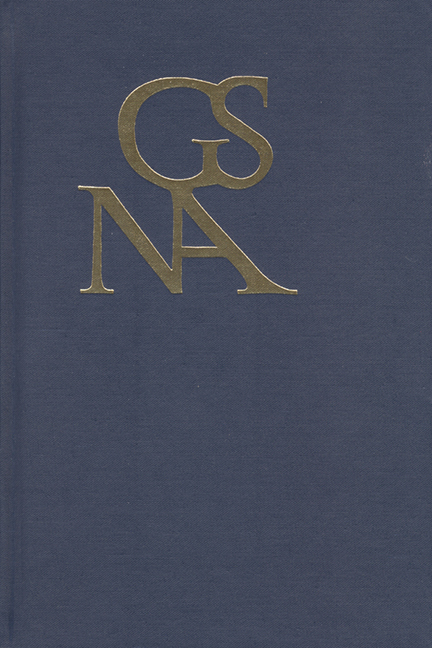Book contents
- Frontmatter
- Contents
- Reorientations around Goethe
- Reorientations around Goethe II
- Special Section on Goethe's Narrative Events edited by Fritz Breithaupt
- What Is an Event for Goethe?
- Much Ado about Nothing? The Absence of Events in Die Wahlverwandtschaften
- Countering Catastrophe: Goethe's Novelle in the Aftershock of Heinrich von Kleist
- Narrating (against) the Uncanny: Goethe's “Ballade” versus Hoffmann's Der Sandmann
- Remembering Klopstock's Mitausdruck
- Strategic Indecision: Gender and Bureaucracy in Schiller's Maria Stuart
- The Dark Green in the Early Anthropocene: Goethe's Plants in Versuch die Metamorphose der Pflanzen zu erklären and Triumph der Empfindsamkeit
- Abschlussbewegungen: Goethe, Freud, and Spectral Forms of Life
- Ein Mythos und sein doppelter Entzug des Modernen: Prämissen für einen Ausweg aus der Unübersichtlichkeit der Faustforschung
- Johann Wolfgang von Goethe in Conversation with Things
- World Literature Turns Political, 1835/36: The Early Afterlife of Goethe's Pronouncement in German Cultural-Politics and in the Young Germany Movement
- Fritz Strich and the Dilemmas of World Literature Today
- A Jewish Faust Commentary: Notes on Franz Rosenzweig's The Star of Redemption
- From Idylle to idílio: Mário de Andrade's Parody of Hermann und Dorothea
- Koselleck's Timely Goethe?
- Book Reviews
Johann Wolfgang von Goethe in Conversation with Things
from Special Section on Goethe's Narrative Events edited by Fritz Breithaupt
Published online by Cambridge University Press: 26 June 2019
- Frontmatter
- Contents
- Reorientations around Goethe
- Reorientations around Goethe II
- Special Section on Goethe's Narrative Events edited by Fritz Breithaupt
- What Is an Event for Goethe?
- Much Ado about Nothing? The Absence of Events in Die Wahlverwandtschaften
- Countering Catastrophe: Goethe's Novelle in the Aftershock of Heinrich von Kleist
- Narrating (against) the Uncanny: Goethe's “Ballade” versus Hoffmann's Der Sandmann
- Remembering Klopstock's Mitausdruck
- Strategic Indecision: Gender and Bureaucracy in Schiller's Maria Stuart
- The Dark Green in the Early Anthropocene: Goethe's Plants in Versuch die Metamorphose der Pflanzen zu erklären and Triumph der Empfindsamkeit
- Abschlussbewegungen: Goethe, Freud, and Spectral Forms of Life
- Ein Mythos und sein doppelter Entzug des Modernen: Prämissen für einen Ausweg aus der Unübersichtlichkeit der Faustforschung
- Johann Wolfgang von Goethe in Conversation with Things
- World Literature Turns Political, 1835/36: The Early Afterlife of Goethe's Pronouncement in German Cultural-Politics and in the Young Germany Movement
- Fritz Strich and the Dilemmas of World Literature Today
- A Jewish Faust Commentary: Notes on Franz Rosenzweig's The Star of Redemption
- From Idylle to idílio: Mário de Andrade's Parody of Hermann und Dorothea
- Koselleck's Timely Goethe?
- Book Reviews
Summary
Wir bringen wohl Fähigkeiten mit, aber unsere
Entwicklung verdanken wir tausend Einwirkungen
einer großen Welt, aus der wir uns aneignen, was wir
können und was uns gemäß ist.
[While we have innate talents, we owe our development to thousand influences of an expansive world from which we select for ourselves what we can and what is suitable for us.]
—Johann Wolfgang von Goethe, 1828JOHANN WOLFGANG VON GOETHE surrounded himself with collections at home ranging from art and cameos, rock formations and bones to wallpaper and furnishings. His observations on things are brief and unsystematic, but can be found throughout his oeuvre in various genres. Reconstructing the important role of tangible, inanimate objects in Goethe's spatial environment from his remarks in several of his nonfictional narratives, letters, and essays, I argue that objects serve as a medium for social interaction, such as collecting, gift exchanges, and enhancing sociability. Here we could say with Michael Callon that objects act as “intermediaries for human action.”
In addition, objects serve a more complex role: things support Goethe's form of conceptualizing, clarified spatial relationships, sparked observations, engendered insights, and evoked memories. These often interrelated dimensions in Goethe's thinking on objects and their association with the subject, influenced not only Goethe's lifestyle but also his worldview. This dynamic of intra-activity between subject and object (and to a lesser degree among things), allowed Goethe to stage his environment to maximize the influence of objects in his way of living, which supported his way of knowing.
The more general question raised by Goethe's connection to the object is whether he offered a new way of thinking about the boundaries between subject and object. My argument is that Goethe's ontology favors an open stance of the subject that ascribes a highly significant role to the object in a dynamic interactive relationship as we will explore below.
The Visual Dimension
While the subject-object relationship is a frequent topic in the philosophy of the time, this exceeds the scope of this article, as we focus here on visual dimension. Scholarship on this relationship in the area of the visual arts focuses predominantly on Goethe's life-altering experiences in Italy.
- Type
- Chapter
- Information
- Goethe Yearbook 26Publications of the Goethe Society of North America, pp. 199 - 216Publisher: Boydell & BrewerPrint publication year: 2019



